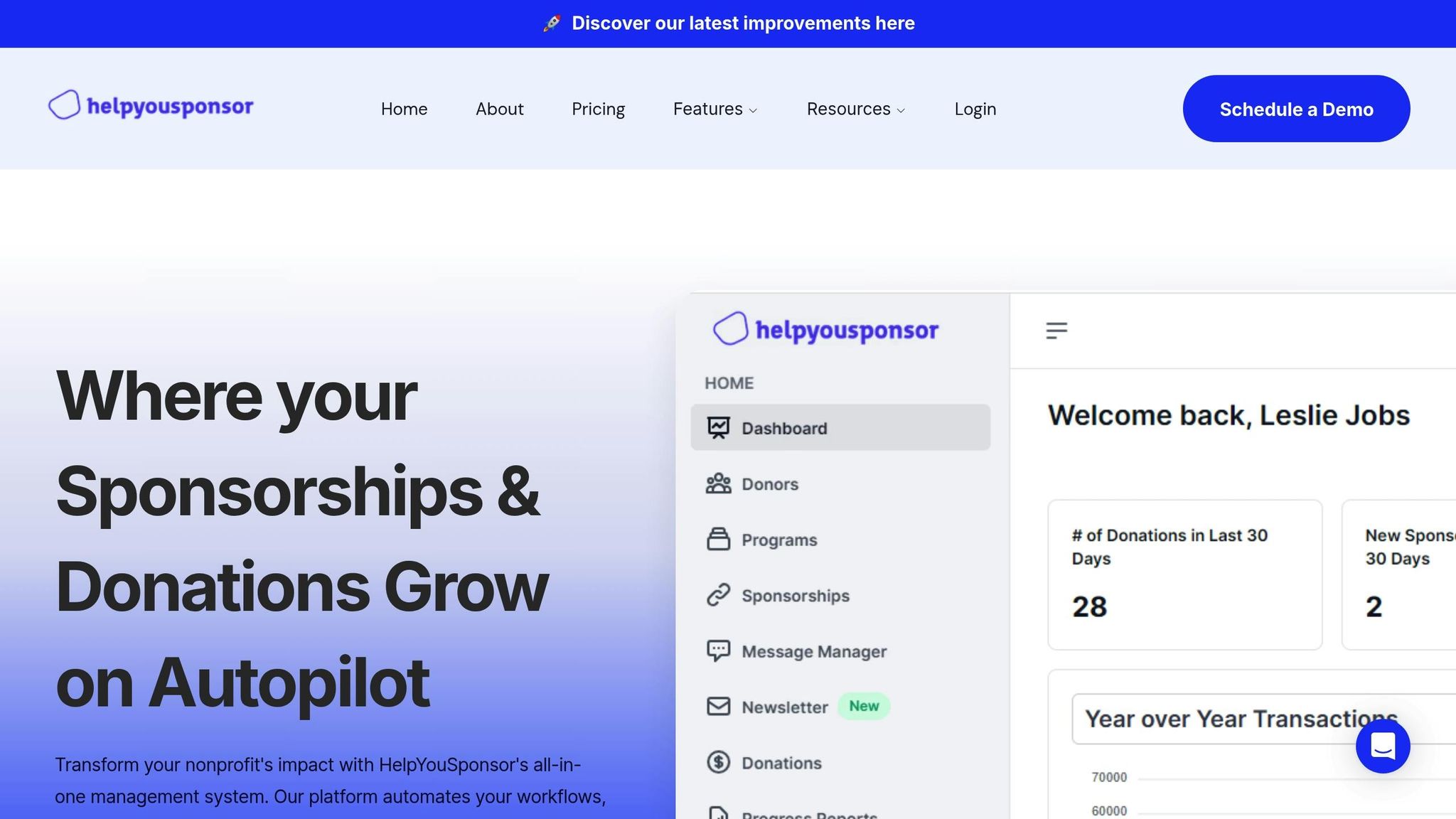10 KPI Examples for Child Sponsorship Programs
Explore 10 essential KPIs for child sponsorship programs that enhance donor trust, track impact, and improve retention strategies.

Tracking the right KPIs is essential for running a successful child sponsorship program. These metrics help organizations measure impact, build donor trust, and improve retention. Here are 10 key KPIs to focus on:
- Educational Progress: Literacy rates and school attendance show academic impact.
- Health Metrics: Vaccination coverage and growth milestones highlight physical well-being.
- Psychosocial Development: Self-confidence and social skills assessments track emotional growth.
- Sponsor Retention Rate: Measures how many sponsors renew their support over time.
- Average Sponsorship Duration: Tracks how long sponsors stay committed.
- Engagement Frequency: Email open rates and event participation indicate sponsor involvement.
- Sponsor Satisfaction (NPS): Gauges how likely sponsors are to recommend the program.
- Program Enrollment Rate: Tracks how effectively new sponsors are acquired.
- Churn Rate: Measures the percentage of sponsors who stop their support.
- Community-Level Outcomes: Tracks broader impacts like access to clean water and infrastructure improvements.
These KPIs combine data with real-world outcomes, helping nonprofits demonstrate progress and build stronger sponsor relationships. Tools like HelpYouSponsor simplify tracking by centralizing data into easy-to-use dashboards, making it easier to manage and communicate program success.
A Crash Course on KPIs for Nonprofits - Tasi Gottschlag
1. Educational Progress Metrics (Literacy Rates, School Attendance)
Educational progress metrics are essential for understanding how sponsorship programs impact children's academic development. They provide clear evidence that contributions are making a difference in improving educational outcomes.
Literacy rates serve as a primary measure of success. This metric tracks the percentage of sponsored children who achieve reading and writing skills appropriate for their grade level. Progress is monitored through standardized testing, offering a consistent way to evaluate literacy growth.
School attendance rates are another important indicator, reflecting how engaged students are in their education. By tracking daily attendance, this metric not only highlights students' commitment to learning but also demonstrates how effective the program is in ensuring children attend school regularly.
Accurate tracking depends on systematic data collection. Schools provide attendance records, and standardized tests are used to measure literacy. Feedback from teachers and field workers adds valuable context to the data, while trained staff and strict quality controls help maintain accuracy.
Improvements in literacy and attendance aren't just numbers - they play a critical role in strengthening the connection between donors and the children they support. These measurable outcomes make it easier to communicate the program's success and its positive impact.
2. Health and Wellness Indicators (Vaccination Coverage, Growth Milestones)
Health and wellness indicators offer a clear picture of how child sponsorship programs contribute to children's physical health and overall growth. These measurements go beyond education to highlight the broader impact of these programs on well-being. Here are two key areas that shed light on these benefits:
Vaccination coverage tracks the percentage of sponsored children receiving immunizations recommended by national health guidelines. By comparing these rates to local or regional averages, organizations can show how sponsorship programs improve access to preventive care. This often involves addressing financial hurdles that might otherwise prevent families from obtaining vaccines for their children.
Growth milestones, such as height and weight, help identify potential issues like malnutrition or stunted growth early on. By monitoring these metrics over time, programs can assess the success of their nutritional support and make necessary adjustments to improve outcomes.
To effectively track these indicators, partnerships with local healthcare providers and community health workers are essential. These teams conduct regular health screenings and maintain detailed records, ensuring even children in remote areas are closely monitored.
Sharing improvements in health metrics can tell a compelling story about the transformative effects of sponsorship programs. These narratives not only highlight the impact but also encourage continued donor support.
Ongoing monitoring also allows organizations to adapt their strategies. For instance, if vaccination rates fall short, resources can be redirected to strengthen healthcare efforts and expand vaccine outreach programs.
3. Psychosocial Development KPIs (Self-Confidence Assessments, Social Skills Development)
In addition to educational and health metrics, psychosocial KPIs provide a more complete understanding of children's overall growth. These metrics focus on emotional and social development, offering insights into how children view themselves and interact with others. Together, they help paint a fuller picture of how programs influence young lives.
Self-confidence assessments focus on understanding a child's self-perception. These evaluations rely on methods like interviews, observations, and feedback from educators. By establishing a baseline and conducting periodic assessments tailored to the community's cultural context, it becomes possible to track meaningful changes over time.
Social skills assessments examine how children engage with peers, adults, and their broader community. Feedback from teachers, program staff, and community liaisons is key to evaluating areas like communication, teamwork, and conflict resolution. These insights provide a deeper look at social development.
When combined with educational and health data, psychosocial metrics help create a more comprehensive understanding of a program’s impact. This integrated approach also allows interventions to adapt as children’s needs evolve.
4. Sponsor Retention Rate
Sponsor retention rate reflects how many sponsors continue to support their sponsored child over time. This metric is essential for understanding long-term program stability, as it focuses on retaining existing sponsors rather than relying solely on acquiring new ones.
The formula to calculate sponsor retention rate is straightforward:
(Renewed sponsors ÷ Previous sponsors) × 100
For instance, if you had 1,000 sponsors last year and 850 of them renewed their support this year, your retention rate would be 85%.
Keeping sponsors engaged requires consistent, personalized communication. Sponsors who receive tailored updates - like progress reports, photos, and personal messages about their sponsored child - are more likely to maintain their commitment. Highlighting specific achievements, such as improved school attendance or better nutrition, helps build a stronger emotional connection. Transparency also plays a key role; when sponsors see clear evidence of how their contributions are making a difference, their trust and loyalty grow.
Technology offers powerful tools to improve retention. For example, donor lifetime value analysis and AI-driven engagement strategies can identify sponsors who might be at risk of discontinuing their support. This allows organizations to act early with targeted campaigns, keeping the relationship intact. Digital tools like these, combined with staff training on effective communication and retention strategies, can significantly strengthen sponsor relationships over time.
5. Average Sponsorship Duration
The average sponsorship duration measures how long sponsors stay committed to your program. This metric adds a time-based perspective to sponsor retention, giving you a clearer picture of donor loyalty.
To calculate it, take the total number of months from all completed sponsorships and divide it by the number of sponsors who have ended their support. For example, if 100 sponsors collectively contributed 2,400 months of support, the average duration would be 24 months (or two years).
This figure isn’t just about tracking time - it’s a cornerstone for understanding donor lifetime value. Let’s say sponsors typically commit for 30 months and donate $35 per month. That means each sponsor contributes about $1,050 over their time with the program. Knowing this helps shape smarter fundraising strategies.
What’s more, tracking sponsorship duration can fine-tune your retention efforts. Sponsors who feel a personal connection - through updates like photos, school reports, or handwritten letters - are more likely to stick around. Scheduling regular communication, such as quarterly updates or celebratory messages, can make a big difference in maintaining those relationships.
Analyzing when sponsors tend to disengage can also help you act preemptively. If you notice a trend where commitments drop off after a certain period, you can introduce targeted retention campaigns. For instance, you might share major milestones, send heartfelt thank-you messages, or even host virtual meet-and-greet events to keep sponsors engaged.
Finally, understanding multi-year commitments can guide resource allocation and long-term planning. Combined with retention rates, the average sponsorship duration becomes a powerful tool for building a solid foundation for your program.
6. Engagement Frequency Metrics (Email Open Rates, Event Participation)
Engagement frequency metrics go beyond tracking monthly donations - they measure the depth of the relationships you're building with your sponsors. These metrics focus on how connected and involved your sponsors are with your mission.
Email open rates are a great starting point for gauging sponsor interest. When sponsors regularly open your updates, progress reports, or event invitations, it’s a clear sign they’re actively engaged with your cause. To keep this momentum, make sure your communications highlight meaningful milestones and achievements that resonate with them.
Event participation is another key indicator of sponsor commitment. Whether it’s attending virtual meet-and-greets with sponsored children, joining fundraising events, or taking part in online awareness campaigns, these actions show a deeper emotional investment. Sponsors who actively participate are more likely to remain loyal supporters over time.
It’s also worth looking at engagement across multiple channels. A sponsor might not attend every event, but they could be liking your social media posts, completing surveys, or joining online discussions. By tracking involvement across different platforms, you get a fuller picture of how connected they are to your mission. This broader perspective helps you strengthen those relationships even further.
Timing plays a role too. Many sponsors, especially those with busy work schedules, are more likely to engage during evenings or weekends. Tailoring your outreach to fit these patterns can make your efforts more effective.
Lastly, low engagement doesn’t always mean a lack of interest. Some sponsors might prefer less frequent communication or engage in other ways. Use your data to identify your most active supporters - they’re often the ones who will advocate for your program, refer friends, or even increase their contributions. These highly engaged sponsors can play a big part in building a long-lasting and thriving sponsorship program.
7. Sponsor Satisfaction and Net Promoter Score (NPS)
Net Promoter Score (NPS) offers a simple way to measure how satisfied your sponsors are and whether they'd recommend your child sponsorship program to others. The key question to ask is: "On a scale of 0–10, how likely are you to recommend our program?"
Responses fall into three groups: Promoters (9–10), Passives (7–8), and Detractors (0–6). Promoters are your biggest supporters, eager to spread the word about your program. Passives are content but less likely to actively promote it. Detractors, however, may have concerns that could negatively influence others.
The beauty of NPS lies in its simplicity. You calculate the score by subtracting the percentage of detractors from the percentage of promoters. This single number provides a clear snapshot of overall sponsor sentiment and helps gauge loyalty and enthusiasm.
To gain deeper insights, follow up with additional questions. For example, ask promoters what they value most about the program - these responses could lead to powerful testimonials for your outreach efforts. On the other hand, understanding detractors’ concerns gives you the chance to address issues and improve their experience. It’s an effective way to enhance communication and build stronger sponsor relationships.
Beyond NPS, consider other factors that influence satisfaction, like how often you communicate, the transparency of your updates, and the quality of the information you share. Tailor your approach based on this feedback to create a more personalized experience.
Tracking NPS trends over time is also crucial. A drop in your score can signal potential problems in your program or communication strategy, giving you the opportunity to make adjustments before they escalate.
Finally, leverage insights from your most enthusiastic supporters. Encourage them to share success stories or participate in events. Their involvement not only strengthens their connection to the program but also amplifies its positive impact to others.
8. Program Enrollment Rate
The program enrollment rate shows how well your child sponsorship program attracts new sponsors. It tracks the percentage of available sponsorship opportunities that are filled within a set timeframe. This metric offers a clear snapshot of your program's appeal and how effective your outreach efforts are.
To calculate it, divide the number of new sponsorships secured by the total number of available sponsorship opportunities, then multiply by 100. For instance, if 200 children are waiting for sponsors and you secure 50 new sponsorships in a quarter, your enrollment rate would be 25%.
Showing measurable results is key to attracting new sponsors. When potential donors see clear evidence of how their contributions make an impact, they’re more likely to commit. Highlighting program outcomes and sharing success stories can help showcase your program’s effectiveness.
The strategies you use to acquire donors play a big role in enrollment rates. Data-driven storytelling is particularly effective - combining emotional stories of individual children with solid statistics creates a compelling case for support. This approach ties back to the importance of measurable impact.
Personalized communication is another essential factor. Instead of relying on generic materials, tailor your outreach to align with donor interests and motivations. This personal touch not only helps convert prospects into sponsors but also fosters long-term loyalty.
Technology can also take your enrollment efforts to the next level. Digital tools and modern platforms streamline processes, making resource allocation more efficient. For example, analytics and AI-powered tools can identify high-potential prospects and automate responses, saving time and effort. To manage costs, calculate the total expense of acquiring each new sponsor, including marketing, staff time, and materials. This helps pinpoint the most cost-effective channels and strategies.
Tracking your enrollment rate regularly - both monthly and quarterly - provides valuable insights. It helps you spot trends and seasonal patterns. A drop in the rate could signal issues with your messaging, outreach, or program positioning that need immediate attention. By monitoring these trends, you can quickly adjust your approach to keep your program on track.
9. Churn Rate
Churn rate shows the percentage of sponsors who stop their support, making it a key indicator of both sponsor retention and the overall health of your program.
To calculate it, use this formula: (Number of sponsors who stopped support ÷ Total sponsors at the start of the period) × 100. For example, if you begin with 1,000 sponsors and 150 decide to leave, your churn rate is 15%. This simple calculation provides a clear picture of how well you're holding onto your supporters.
Lowering churn is critical for maintaining the long-term success of your program. By focusing on donor retention strategies - like building strong, lasting relationships - you can reduce churn and ensure your program continues to make an impact.
10. Community-Level Outcomes (Access to Clean Water, Infrastructure Improvements)
Community-level outcomes highlight the broader impact of your program, showcasing how your efforts benefit entire communities, not just individual sponsored children. These metrics help illustrate the ripple effect of your initiatives, offering a clearer picture of the long-term changes you're driving.
One key measure is access to clean water. This involves tracking the percentage of households with safe drinking water, counting the number of water points installed, and reviewing water quality test results. These figures provide a tangible way to assess how your work is addressing a critical need.
Another important indicator is infrastructure improvements. By monitoring the number of schools renovated or healthcare facilities established in your program areas, you can demonstrate how sponsorship funds are being used to create lasting benefits for the community. These metrics not only showcase the tangible results of your efforts but also lay the groundwork for continued performance tracking.
For donors, this data offers valuable context. It shows how their contributions go beyond individual lives to foster widespread community development. Measuring program impact effectively is crucial for nonprofits, and community-level data strengthens overall program assessments while enhancing donor engagement through compelling, data-backed narratives.
Regular tracking - whether annually or bi-annually - enables you to benchmark progress in new communities and measure cumulative achievements over time. This consistent approach helps illustrate the transformative changes your sponsorship program brings to entire communities.
Using HelpYouSponsor for KPI Tracking

HelpYouSponsor makes it easier to track the ten key performance indicators (KPIs) for child sponsorship programs. By aligning with the KPIs mentioned earlier, the platform ensures that every metric is tracked with precision.
One of its core features is centralized donor tracking, which monitors sponsor-related KPIs like retention, engagement, and satisfaction. The system automatically logs donation histories, communication preferences, and engagement levels, providing real-time insights into sponsor relationships. This foundational integration supports all other KPI tracking functions.
"Empowering nonprofits with automation insights, expert strategies, and product updates to revolutionize sponsorship and donation management."
Another highlight of HelpYouSponsor is its custom KPI dashboards. With the "Save Custom Views in the Donations" feature, you can create dashboards tailored to your specific needs. Whether you're preparing data on educational progress for a board meeting or showcasing community-level outcomes in a grant application, these custom views allow you to focus on the metrics that matter most to your stakeholders.
The platform also includes an integrated messaging system that tracks email open rates, response times, and communication patterns. This data feeds directly into KPI calculations, eliminating the need for juggling multiple systems. It helps you quickly identify sponsors who are highly engaged and those who might need additional outreach.
HelpYouSponsor's automated reporting tools combine financial data with program outcomes. These reports make it easy to show the link between sponsor contributions and tangible results, such as improved literacy rates, increased vaccination coverage, or advancements in community infrastructure.
"Our latest updates are here to streamline your efforts and build lasting bonds with your donors."
The platform also features integrated payment gateways that track sponsorship duration and enrollment rates. It automatically captures donation frequency, amounts, and timing, enabling you to calculate financial KPIs without manual effort. Additionally, it helps track churn rates by identifying when regular donations stop or become inconsistent.
HelpYouSponsor's website integration capabilities bring your KPI tracking full circle by including web-based engagement data. You can monitor how potential sponsors interact with child profiles, track conversion rates from website visits to sponsorships, and assess the success of various fundraising campaigns. Together, these tools ensure seamless tracking of KPIs, from sponsor engagement to community outcomes.
For nonprofits focused on community-level projects, the platform supports tracking broader metrics like infrastructure improvements and community development. By linking individual sponsorship data to larger initiatives, it provides a comprehensive view of how every contribution contributes to collective progress.
Lastly, the platform's intuitive interface ensures that staff can easily input and access KPI data without needing extensive technical expertise. This ease of use not only simplifies data management but also helps sustain the program's long-term success.
Conclusion
Tracking KPIs is more than just a numbers game - it’s about building trust, showing impact, and strengthening relationships with sponsors. With 62% of nonprofit leaders in 2025 identifying donor retention as their top priority, focusing on the right metrics is critical to achieving long-term success.
From tracking educational milestones to measuring broader community progress, these metrics empower nonprofits to craft data-driven stories that resonate with both current and potential sponsors. By consistently monitoring KPIs, organizations can demonstrate the tangible difference sponsors’ contributions make, reinforcing confidence in how funds are used.
However, managing a wide range of metrics manually can be overwhelming for nonprofit teams. That’s where automated platforms like HelpYouSponsor come in. These tools simplify the tracking process by centralizing data into easy-to-use dashboards. Features like custom views allow nonprofits to tailor their focus to the metrics that matter most - whether they’re preparing for a board presentation or submitting a grant proposal. By eliminating the need for juggling multiple systems and spreadsheets, these platforms free up time and resources for what truly matters: driving impact.
The real magic happens when nonprofits combine measurable results with emotional storytelling. While the data provides proof of progress and accountability, the personal stories behind those numbers inspire deeper connections and sustained support. When organizations can seamlessly present both the hard facts and the human impact, they create a narrative that keeps sponsors engaged for the long haul.
For nonprofits looking to maximize their reach and build lasting sponsorship programs, investing in effective KPI tracking isn’t optional - it’s essential. The right tools and a clear focus on metrics not only strengthen relationships but also help transform the lives of children and communities. By blending data with heartfelt stories, nonprofits can create sponsorship programs that are both impactful and enduring.
FAQs
How do child sponsorship programs use KPIs to boost donor loyalty and engagement?
Child sponsorship programs rely on key performance indicators (KPIs) to track and enhance donor loyalty and engagement. These metrics often cover areas like donor satisfaction, how often and effectively organizations communicate, and how clearly they share program results.
By digging into these KPIs, nonprofits can pinpoint what needs improvement, customize their outreach to match donor preferences, and highlight the real-world impact of donor contributions. This approach builds trust, deepens connections, and inspires donors to stay committed for the long haul.
Why are community-level outcomes important for the success of child sponsorship programs?
Community-level outcomes matter because they demonstrate how child sponsorship programs bring about long-term, positive changes that extend beyond the lives of individual children. These results - like expanded access to education, better healthcare services, and healthier local economies - show the broader benefits these programs deliver to entire communities.
By prioritizing community development, sponsorship programs not only strengthen resilience but also ensure progress that lasts. This approach amplifies their impact and reinforces the trust and effectiveness of their efforts over time.
How does HelpYouSponsor improve KPI tracking and communication for child sponsorship programs?
HelpYouSponsor makes keeping track of KPIs and sharing updates easier with tools like real-time data dashboards, automated reports, and centralized data management. These tools provide accurate, up-to-the-minute insights, allowing nonprofits to share clear and transparent updates with their stakeholders.
By simplifying how data is collected and reported, HelpYouSponsor helps organizations make smarter, informed decisions based on data. At the same time, it strengthens trust with donors and sponsors, leading to a more effective and meaningful child sponsorship program.

